After working with several startups, I’ve seen exactly which scrappy marketing tactics drive leads and revenue — without draining time or budget. If you're scaling a startup, these are the strategies that actually work.
Table of Contents
10 Non-Negotiables of a Digital Marketing Strategy for Startups
- Use SMART goals to focus on business-critical goals upfront.
- Create detailed documents to distinguish who your target buyers are.
- Have clear, compelling messaging.
- Create a content marketing strategy to generate leads.
- Distribute the content you create.
- Run ads for short-term results.
- Implement a digital PR strategy to increase buzz around your brand.
- Measure and improve customer lifetime value (CLV).
- Establish and cultivate your reputation.
- Build a referral engine.
1. Use SMART goals to focus on business-critical goals upfront.
When I started helping startups with their marketing, I noticed a common pattern: many tried to do everything at once. Through trial and error, I learned that focusing on a few business-critical SMART goals works much better than spreading yourself thin. These are goals that are Specific, Measurable, Attainable, Relevant, and Timely.
In my work with early-stage companies, I've found these types of SMART goals particularly effective:
- Increase organic traffic to our website by 50% by 2022
- Create 10 new sales-focused blogs by Q3
- Secure five placements in online media using digital PR by X date
The purpose of SMART goals is to set businesses up for success. They provide a sense of direction and help to organize efforts.
And, while SMART goals are invaluable for any organization, they're particularly beneficial for start-ups.
Instead of trying to do everything at once, focus on the most business-critical goals, put everything you have behind them, and tackle things in a strategic way.
For instance, rather than spreading your time across several initiatives (some of which may not be important right now), focus on three or four that will lay a foundation for your activities or support your current efforts.
If you're launching a new product, for instance, focus on the development but also set goals like:
- Create 10 new blogs to build awareness of the product by X date
- Publish two new web pages to promote the new product by X date
- Secure five placements in online media using digital PR by X date
These are just some examples, but they can undoubtedly help raise the profile of your business idea without costing much — the only real expenditure is time. Instead of spreading your capabilities across several initiatives, try focusing on those that will support what you're doing right now.
The key to sustained growth is consistency and focus, and SMART goals enable you to do just that.
2. Create detailed documents to distinguish who your target buyers are.
SMART goals give your marketing efforts direction and focus, but who are you marketing to?
For your start-up's marketing efforts to bring in tangible results, those efforts need to be tailored to your ideal target audience.
Now you'll probably have a good understanding of who you want to do business with, but have you articulated that to the rest of your team or — at the very least — put together a document detailing who your buyer personas are?
It‘s here where buyer personas come in handy. Buyer personas are semi-fictional representations of your ideal customers. They’re based on market research, current data, existing customers, and a few educated assumptions.
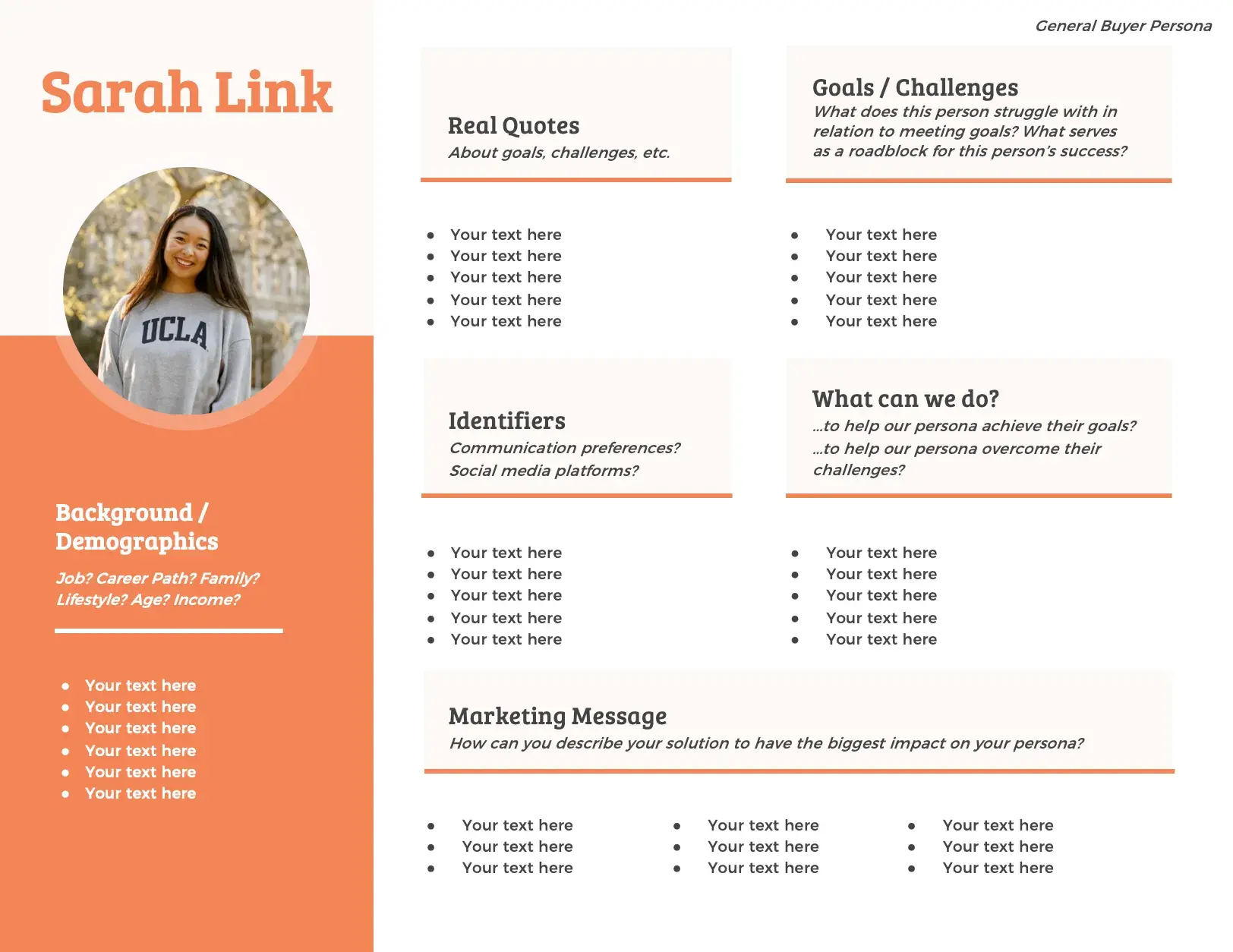
Buyer personas help you understand the drivers, business challenges, and needs of those you want to market.
It's also important to note that buyer personas are not real people but archetypes of them.
Now that we've briefly covered buyer personas, you might be wondering, “Okay, but what makes them so valuable to my start-up?” Buyer personas allow you to refine your marketing and segment your audience(s).
You want and need quick wins during the product development and release stages, so why waste time (and money) casting the widest net possible when you can hone in on those most likely to buy from you?
Your buyer personas give you a good idea of who these people are. Use that information to build marketing and PR campaigns focusing on the right people at the right time and place of their buyer's journey.
3. Have clear, compelling messaging.
If you've ever seen a Ronseal advertisement, you're likely already familiar with the following phrase: “It does what it says on the tin.”
In an age of slick, big-budget marketing campaigns and buzzwords, it falls to you to keep your messages clear and concise.
People don‘t want platitudes or jargon. They want to understand what your product does and how it can help them solve their business challenges. In fact — and this may sound harsh — it’s not even about your business. It's about how you can help your potential customers.
With this in mind, any messaging that your startup creates (and this applies to all businesses of any size) needs to be created with the end user in mind. It needs to be simple, informative, and compelling. This will help convert the website traffic you generate into leads.
4. Create a content marketing strategy to generate leads.
You need a plan for bringing prospects to your site. Content marketing is all about producing high-quality content that answers your prospects and customers' questions, and nurturing them to a point of purchase.
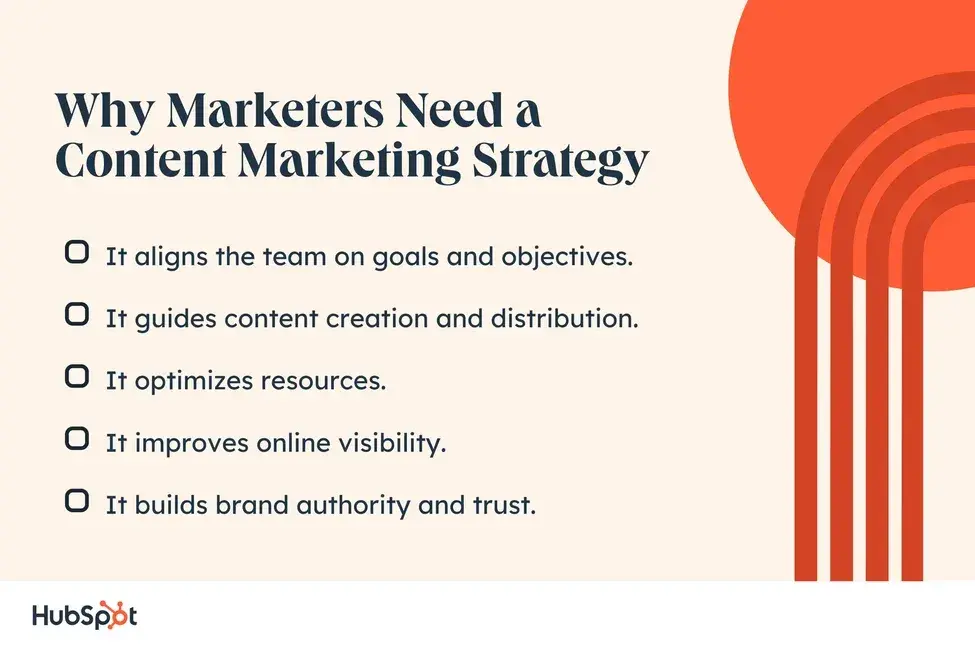
When I work with startup clients now, I always emphasize that blogs are just the beginning. Each piece needs to be optimized for long-tail keywords that your target audience actually searches for. I've seen this simple approach help numerous startups build their digital footprint without a massive marketing budget.
The content you create also helps to generate leads and demonstrate your expertise. You could, for instance, produce informative ebooks and gate them behind landing pages on your website. Visitors can then download your ebooks in exchange for their details.
With this approach, you know that those who do download your ebooks are interested in hearing from you. The ebooks you create will be particularly useful for targeting “early adopters” i.e., those who want to be updated when it comes to new tech.
Over time, as more and more content is created, your website becomes a repository for information. Providing it's all optimized for the right terms, the right people will find it time and time again.
5. Distribute the content you create.
It‘s not enough to hit "Publish" and wait for customers to show up. After all, content marketing doesn’t only work for organic search engine traffic. To get the most bang for your buck, you can repurpose the content you create, distribute it on non-search channels such as social and email, and promote it to new and existing audiences alike.
Let's take a blog post for example. If you created a listicle that outlines 10 tips, you can create a social media graphic for each of the tips and do an informational series for your followers while promoting the full article and/or a related content offer.
A social media plan like this should be part of every content marketing strategy, and every content marketing strategy should be developed with distribution in mind.
6. Run ads for short-term results.
Content marketing is a long-term play. While it can be extremely rewarding over time, you likely won‘t see immediate results. As you build your content platform, you’ll need a way to generate leads and ROI in the short term, and the best way to do that is with ads.
Ads are “pay to play,” so they're not as scalable as content marketing, but the benefit is that your ads will be shown to users shortly after you turn on the campaign.
But which ads should you go with first? Your ad strategy will determine that, but a good rule of thumb is this:
- Google Search Ads — Best when people are already aware of the product/service you sell and search Google to find the right provider/vendor.
- Social Ads — Because people don't go on social media specifically to shop, these are best when people are unaware of the product/service, and you can catch their attention in a fun/visual way. Also good for finding niche audiences.
- Display Ads — Best for brand awareness and re-targeting.
7. Implement a digital PR strategy to increase buzz around your brand.
Now if you want to get the most out of everything you do — particularly from a content creation perspective — why not amplify it with digital PR?
Digital PR effectively takes everything good about traditional PR — like press coverage, events, outreach, and thought leadership content — and does the same for the online space. Suddenly, the assets you've created for your marketing activity can be retrofitted to suit PR purposes.
In fact, digital PR goes one step further: the agency you work with will do its utmost to earn backlinks back to your website (editors and publications are notoriously difficult when it comes to keeping links in content). Subsequently, those reading your content via online publications can actually find your business, and the content itself is already optimized for search because you've done it already.
All-in-all, digital PR will help to increase your startup's visibility both online and offline, helping you to get featured in key trade media relating to what you do and cause a positive stir in your industry.
8. Measure and improve customer lifetime value (CLV).
Because it‘s easier and less costly to retain or re-sell to existing customers than acquire new ones, it’s critical for startups to intentionally track CLV and improve on it by:
- Enhancing the customer experience and eliminating friction
- Tracking customer satisfaction and working to improve retention
- Creating a strategy for upselling and cross-selling
9. Establish and cultivate your reputation.
97% of customers read online reviews for local businesses in 2025 (Bright Local). The internet allows customers to be more informed than ever during the buying process. A poor reputation can therefore hurt your marketing and sales efforts while a good reputation may help seal the deal.
With this in mind, you should do what you can to make a positive impression:
- Ask customers for feedback and take action on it.
- Ask for testimonials when you've exceeded expectations.
- Cultivate other types of social proof, such as case studies.
- Respond to online reviews professionally.
10. Build a referral engine.
Despite all the digital marketing strategies and tactics out there, word of mouth is still powerful.
This is especially true for those who intentionally improve the customer experience.
Referrals often happen organically, but a referral marketing strategy can help you generate them faster. For example, you can:
- Identify promoters and ask them if they know anyone who would benefit from your product/service.
- Incentivize customers to refer their friends through a referral program.
- Leverage user-generated content.
- Build campaigns that are mutually beneficial or champion a cause your customers support.
Startup Marketing Ideas
The above strategies can give you a high-level sense of where to go, but executing them is a different story. To get a sense of how a marketing strategy can produce success for your startup, we're going to lay out some ideas. These ideas are from real startups and will help you visualize how a successful strategy can be helpful for your own marketing goals.
1. Use paid ads to build a community.
Workwize is a B2B company that helps businesses manage hybrid workplace solutions and office resources. They use targeted paid LinkedIn ads to connect with office managers, HR leaders, and operations teams struggling with hybrid work challenges.
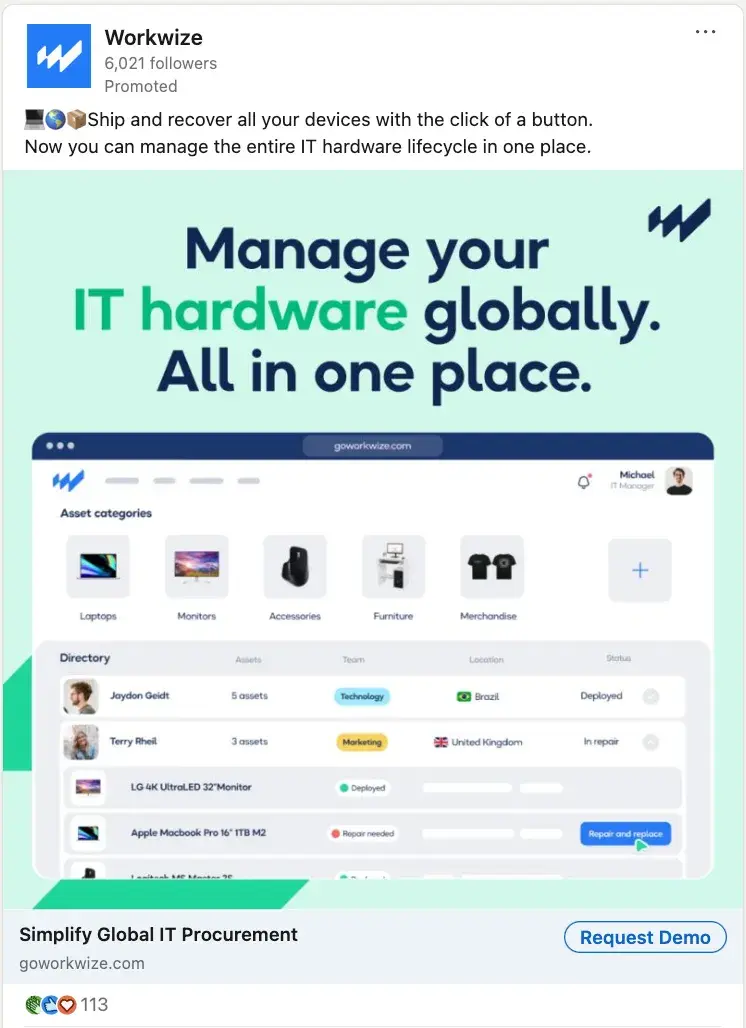
Their LinkedIn ad campaigns focus on relatable pain points like recovering IT devices.
A similar B2B startup strategy could involve making use of a social media platform's paid ads offerings to cater to your audience. Alternatively, you can upload offers for free and use hashtags to get them seen by more prospective customers, like #B2BMarketing or #MarTech.
2. Try social media to connect with customers.
When I advise startups on social media strategy, I always emphasize that you don‘t need a big budget to make an impact. I’ve seen companies build engaged communities simply by sharing authentic content and encouraging user participation.
Take Paperless Parts, for example, a manufacturing company with a stellar Facebook page:

Creating a Facebook Business page and optimizing it is free so leads and customers can find it. The Paperless Parts feed begins with recommendations and reviews from happy customers, showing that the business has a dedicated customer user base.
After that, the business posts videos that go behind the scenes of the manufacturing process and also posts reminders for webinars and other website content.
A social media page for a startup that showcases customers, provides helpful content, and encourages audience participation is a free strategy to expand reach, bring clicks to your website, and show credibility in the industry.
3. Crowdfunding marketing, which can generate press.
Are you thinking about starting a crowdfunding campaign? If you do, you could earn great press from publications, expanding your campaign's reach. Take Exploding Kittens, for example, which started as a simple card game with quirky artwork and a playful concept.
When the creators launched their Kickstarter campaign in 2015, they set a modest goal of $10,000. The campaign went viral, raising $8.7 million from over 219,000 backers, making it the most-backed game project in Kickstarter's history at the time.
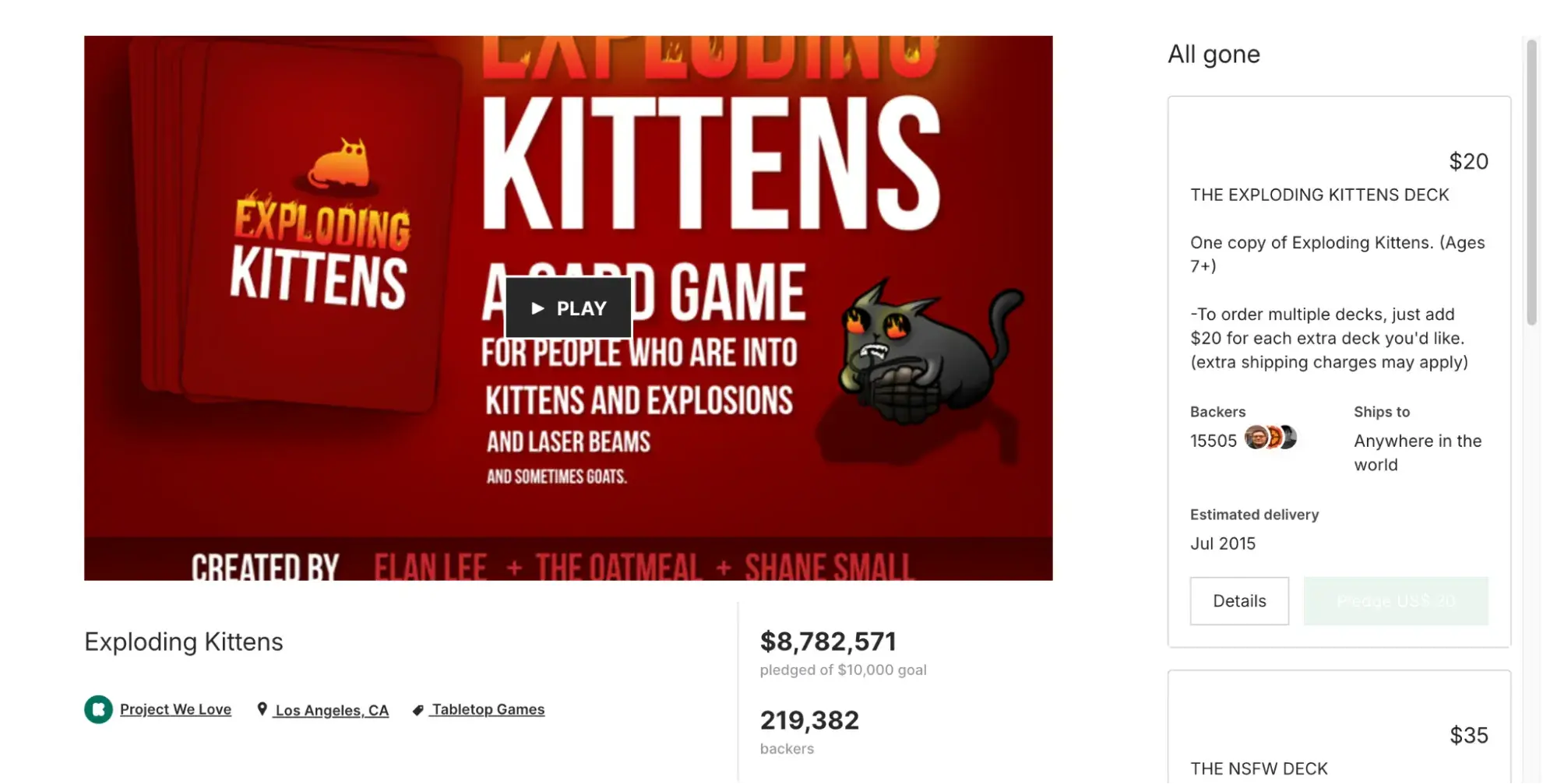
This massive success caught the attention of major media outlets, generating widespread press coverage and building a dedicated fan base before the product even launched.
Even if you have just a few customers, you can use your crowdfunding campaign as a marketing tactic to get more people interested in your business.
4. Host a virtual meetup instead of a conference.
The development platform, GitLab, hosts in-person and virtual meetups to provide developers a platform to share ideas.
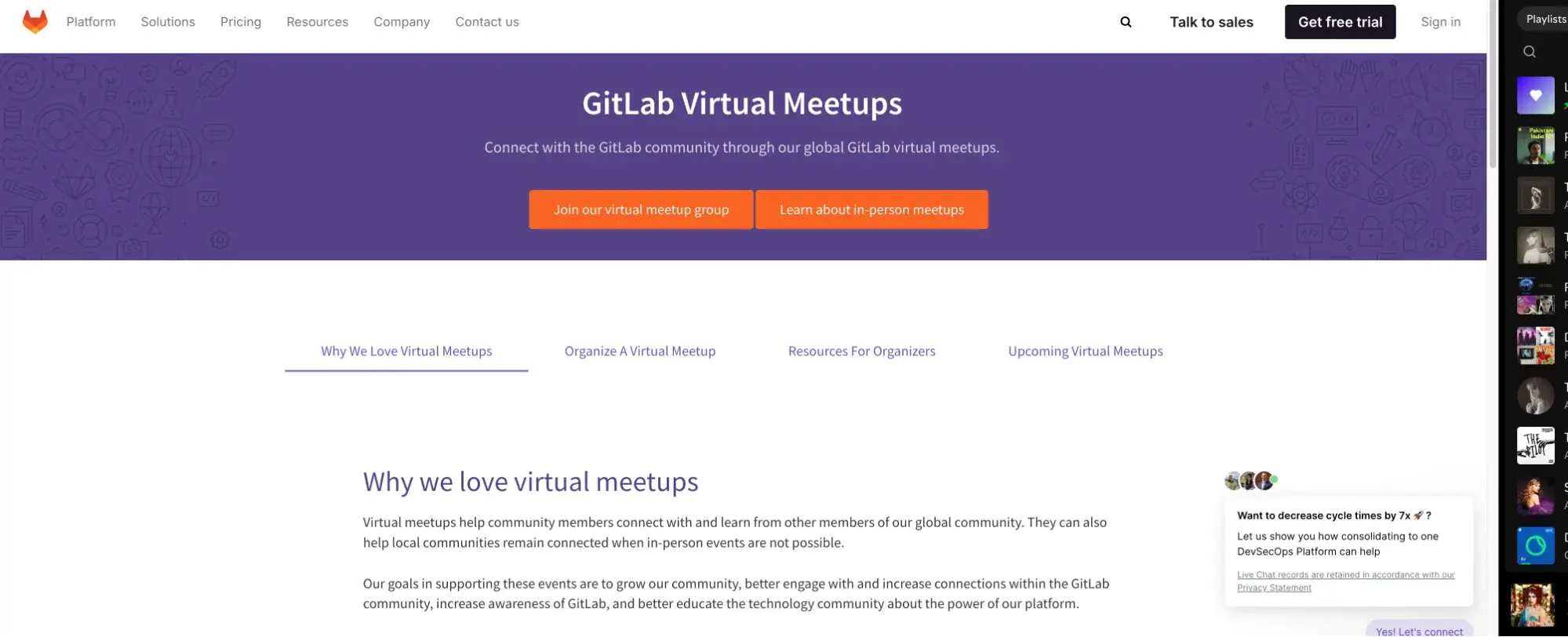
This idea is a cool, low-cost way to expand your professional network and provide valuable content for customers without hosting a conference.
5. Use user-generated content to tell your story.
Startups don't usually have the revenue to produce big-budget social media campaigns. For travel agency Wander Women Retreats, their marketing team found that the best way to tell their story is on Instagram.
The business page is filled with clients enjoying their destination vacations, booked using the service:

A marketing campaign that includes user-generated content is an easy, free way to work in testimonials. You can use your social media channels to execute the campaign and include hashtags for the chance to appear in more feeds.
When thinking about campaign ideas, you might not have to look that far. You might be able to turn some of the tools you already have at your disposal to boost your campaign messages. Is there a webinar you can host about a topic or a content offer you think will resonate particularly well with your LinkedIn audience?
6. Create SEO-optimized content to attract high-intent visitors.
SEO is another free, cost-effective strategy startup marketers can use to spread the word about their business.
But here's the caveat: This one takes the longest of all the strategies mentioned.
While it‘s not incredibly time-consuming, it does require consistent effort. I’ve watched startups boost their lead generation through SEO, but it took months of methodical optimization to get there.
At this point, SEO won't net you leads or opportunities immediately, but it will lay the foundation for consistent success in the months and years to come. In fact, for 88% of consumers, search engines are the best way to get information.
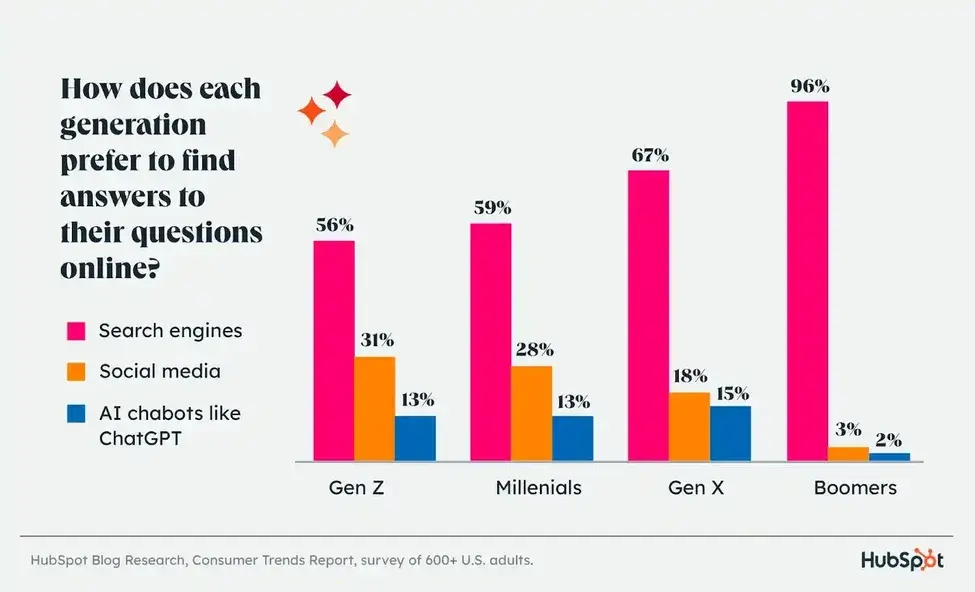
You use SEO to optimize your web pages (and content) for keyword terms you know prospects use to find products or services like yours.
Better yet, you identify long-tail keyword terms with low to medium competition and high search volume relevant to your product or service and use those instead.
Your main service pages will, of course, be competing with other businesses in your space on many similar terms, but you can use the content you create to link to these pages, bolstering their SEO value over time and increasing their ranking on SERP results pages.
Updating and optimizing your website will ensure it continues to grow and attract interested prospects for the long term, so it‘s an opportunity you don’t want to miss.
7. Implement a referral program.
One of the most powerful strategies I've discovered while working with startups is referral marketing. When my clients ask me how to get more customers with a limited budget, I always point them toward building a strong referral program.
Task management app Todoist, for example, has a Partner Program.
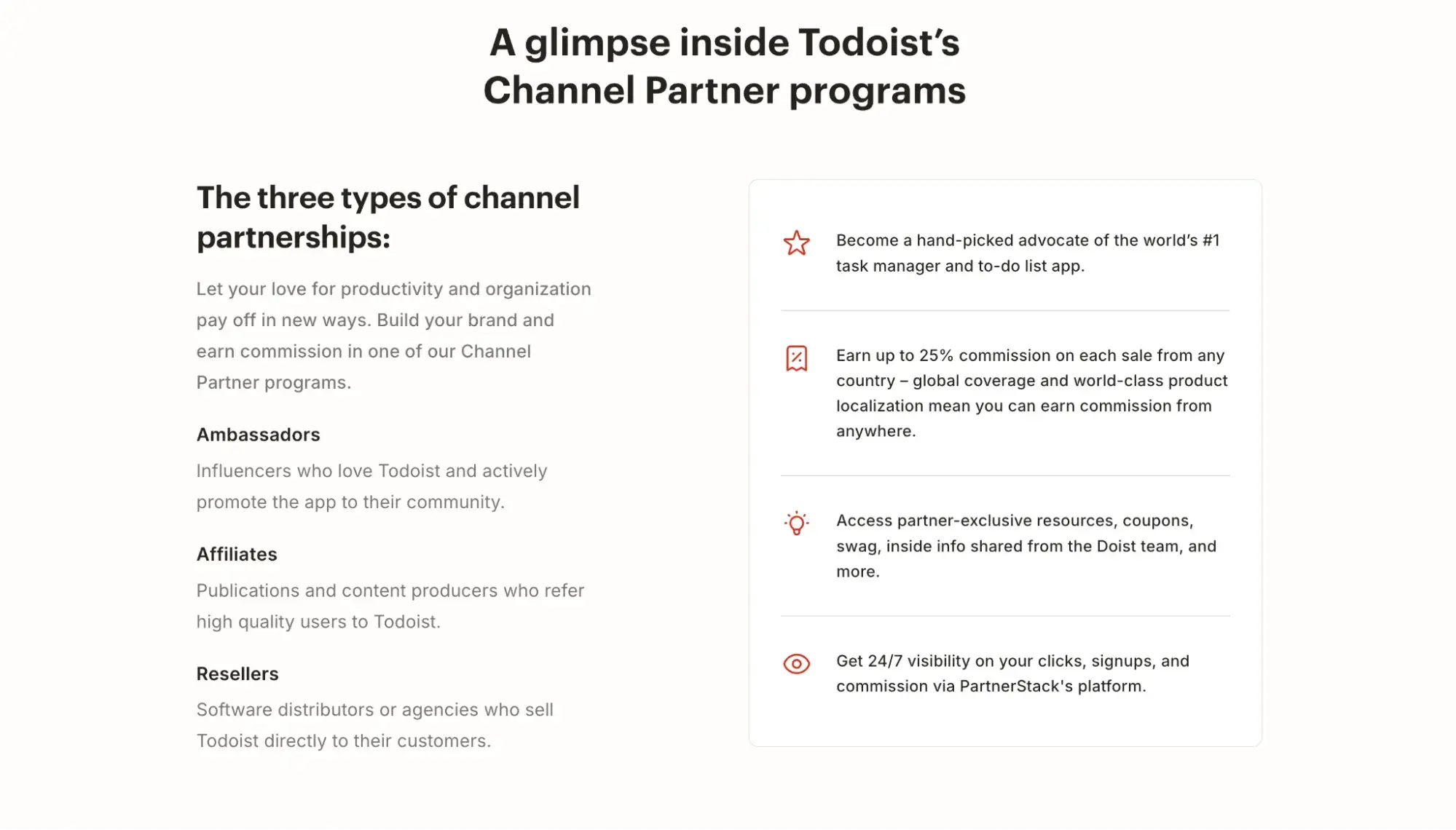
Here‘s what I’ve seen work consistently:
- Collect social proof through customer reviews, testimonials, and case studies that demonstrate your track record of solving real problems
- Incentivize referrals by offering existing customers discounts or free product trials in exchange for their advocacy
- Give free access to tech journalists and industry influencers who can review your product and generate press coverage
- Feature customer reviews prominently across your website to build trust with potential buyers
Make sure to strategically place these testimonials and reviews where potential customers will see them during their decision-making process. They help build trust and authenticity in a way that your own marketing messages can't match.
8. Offer a free or trial version of your product.
One of the best ways to get your startup out there is to offer some kind of version of your product/service for free — and it's worked for many businesses already.
Canva, Dropbox, Zapier, and HubSpot are all high-profile tech companies offering a free/trial version of their product or service to let people try before buying (or upgrading).
As people use them and realize how great these products are, they feel compelled to buy the full, “unlimited” version for all the bells and whistles. Great, right?

But getting people to use your product — and inherently talking about how good it is as a result — is all about lowering the customer's acquisition costs.
What many businesses do with a freemium model is offer current trial users a discount on the full price of the software. This is significantly more appealing than paying the full price and can potentially convert more leads into paying customers very, very quickly.
Also, for those who don't convert to paying customers with this offer, it enables you to understand what features or parts of your service are lacking. You can:
- Ask for feedback from trial users who didn't convert to understand the pain points.
- Make targeted changes based on user feedback and behavior patterns.
- Roll out improvements strategically to test their impact on conversion.
- Track which features drive the most upgrades to inform product development.
For maximum effect, cross-reference what you offer against the main issues your buyer personas have in relation to technology like yours. Consider adding features to your product/service to address these problems (where possible). Maybe produce a roadmap and show people what they'll be getting. Transparency is a great way to increase users.
Lastly, bear in mind that this approach does come with the risk that people might not want to upgrade to the full version. That said, be as clear as you can with what users can get from the full version and highlight how valuable it can be for them. Keep your coolest features under wraps!
5 Startup Marketing Tactics to Explore in 2025
Marketing trends come and go, but 2025 is showing us which tactics drive results for early-stage companies.
These five approaches are gaining significant traction because they focus on efficient growth, helping startups build momentum without requiring massive budgets or large teams.
Build a niche community.
I‘m part of several thriving startup tool communities, and Buffer’s Discord channel stands out as a prime example. They've created a space where users share social media strategies, troubleshoot problems, and connect with other marketers.
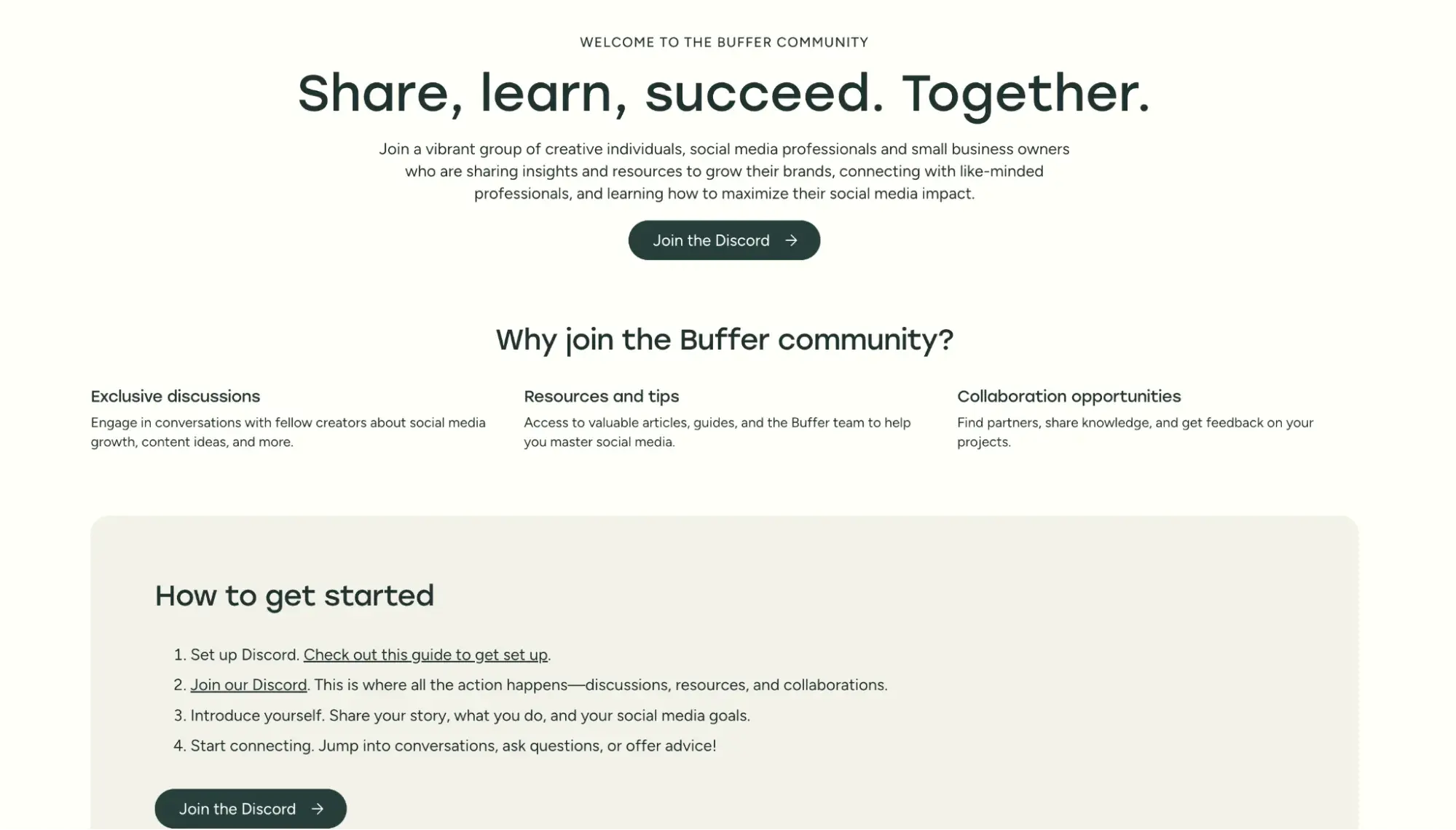
What makes these communities work isn‘t size — it’s relevance. On Slack, Reddit, or Discord, the most engaging groups focus on solving specific problems. Product Hunt runs a focused Slack community for makers, while Notion's Reddit community shares templates and workflows that help users get more value from the tool.
Choose the right platform for your audience. Slack works well for professional communities that need real-time interaction, while Reddit is better for long-form discussions and knowledge sharing.
Pro tip: Start your community with just 10-20 highly engaged members. Give them exclusive access to your product updates and make them feel like true insiders. These early members will set the tone and help attract others.
Use generative AI to speed up your workflow.
Generative AI can help startups punch above their weight class when it comes to content production and research. I use it to brainstorm content angles, summarize market research, and turn long-form content into social posts.
But there's a catch: AI works best as a strategic assistant, not a replacement for human insight.
I use AI to create a custom research workflow. Experimenting with different tools like Claude, ChatGPT, and Perplexity helped me pinpoint the strengths of each and create a system that improves my writing. You can also use tools like HubSpot's Breeze platform for an AI assistant that supports your entire customer platform.
Use AI to suggest multiple headline variations. Identify repetitive tasks where AI can save you time while you focus on strategy and maintaining your brand's unique voice.
Pro tip: Create a “prompt library” in a simple doc where you save your most effective AI prompts. Group them by task type (research, headlines, content repurposing) so you can quickly reuse what works.
Build a personal brand on LinkedIn or Instagram.
I watch founders get this wrong all the time; they hide behind their company logo instead of showing up as themselves. Yet some of my favorite startup tools caught my attention because I followed their founders' journeys on LinkedIn or Instagram first.
Take Marie Martens from the form tool Tally. Her open posts about building in public and sharing revenue numbers built an audience — before the product took off.
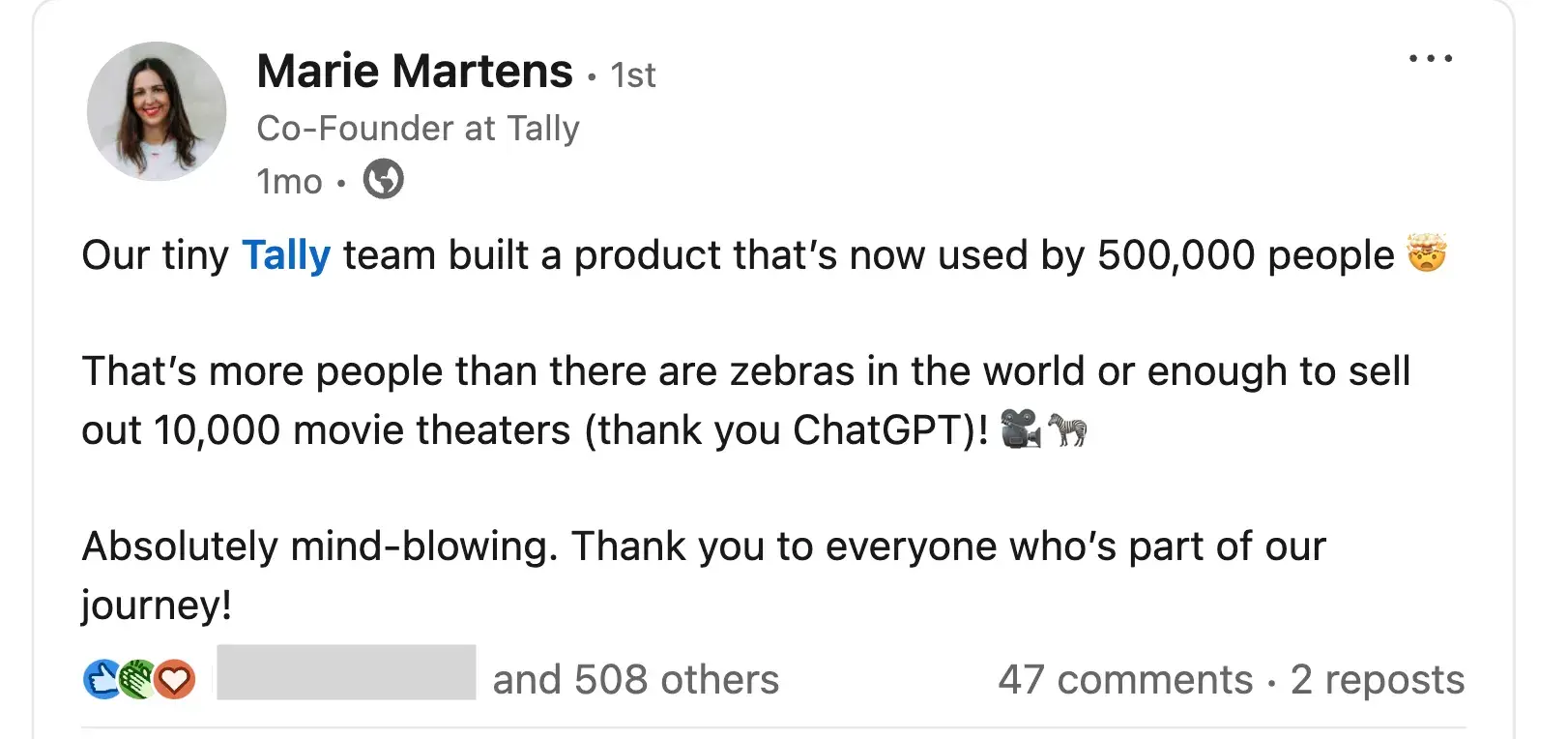
Building your brand doesn‘t mean becoming an influencer. Share your authentic building journey, what you’re learning, and the problems you‘re solving. Use HubSpot’s Social Media Management tool to schedule and track engagement on your posts.
When you do this consistently, you create momentum for your product.
Pro tip: Block 30 minutes every Monday to batch-write three personal posts about your startup journey. Focus on specific lessons learned rather than generic advice — share the exact process, numbers, or tools that moved the needle.
Create short-form video content that converts.
I've been putting off creating short-form video content because I thought I needed fancy equipment and editing skills. Every time I open TikTok or LinkedIn, I see competitors getting massive engagement with simple videos shot on their phones.
I‘m finally planning to experiment with video this quarter, starting small with 60-second tutorials and behind-the-scenes glimpses of my work process. I plan to use HubSpot’s Marketing Analytics to track which social channels drive the most engagement and conversions from my videos.
My research into successful B2B videos shows three principles worth following: Keep videos under 90 seconds, open with the main takeaway, and include a clear next step for viewers.
While I can‘t share personal results yet, I’m convinced enough by other founders' success stories to make video a priority. Sometimes, we have to push past our comfort zone to find marketing channels that work.
Pro tip: Record your first 10 videos without posting them. This practice helps you find your natural style and confidence before going live. Plus, you'll have a content bank ready when you start posting consistently.
Use no-code tools to validate marketing experiments
I used to wait weeks for developer resources before testing new marketing ideas. But, after discovering no-code tools, I'm able to validate concepts in hours instead of months.
Last month, I wanted to test if my audience would sign up for a weekly newsletter about startup marketing metrics. Instead of building a full landing page, I used HubSpot's Landing Page Builder to create a simple signup form in 30 minutes.
After driving some traffic to it with LinkedIn posts, I learned that open rates for “marketing metrics” resonated more than “growth tips” — a valuable insight before I invested in a full content strategy.
My go-to stack for quick marketing tests includes Webflow for landing pages, Zapier for connecting tools, and Airtable for tracking results.
The best part? Most of these tools have free plans that are perfect for early validation. When an experiment works, I can either keep using the no-code version or build a more robust solution.
Pro tip: Before building anything, create a simple spreadsheet with three columns: “Assumption to Test,” “Success Metric,” and “Minimum Viable Test.” This framework prevents overbuilding and keeps experiments focused.
The Best Strategies Use a Combination of Ideas and Tactics
If you want to get the best possible results when it comes to marketing, you need to focus on what works.
I’ve learned that while there are loads of different ways to achieve your goals, it’s always better to focus on the most high-impact and cost-effective, and as a startup owner — I'm willing to bet you already know how important that is.
The best strategies use a combination of what I've mentioned above and then analyze their performance to determine which ones require more or less investment. No matter what you do, remember that your marketing activities are only as good as your goals and targeting.
Editor's note: This post was originally published in April 2020 and has been updated for comprehensiveness.
Marketing Strategy


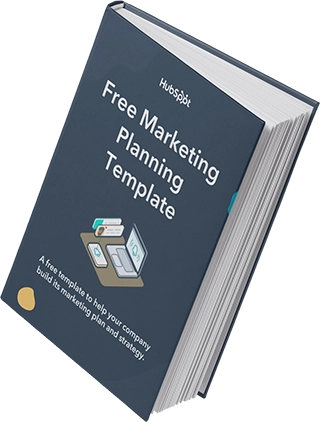
.png)




![The state of inclusive marketing in 2025 [new data + expert insight]](https://53.fs1.hubspotusercontent-na1.net/hubfs/53/inclusive-marketing-report.webp)
![How marketers are navigating a possible recession (and advice about what you should do during it) [new data]](https://53.fs1.hubspotusercontent-na1.net/hubfs/53/image12-May-27-2025-02-18-19-8390-AM.png)



![Cultural Marketing: What It Is & How to Do It The Right Way [According to Experts]](https://53.fs1.hubspotusercontent-na1.net/hubfs/53/Untitled%20design%20-%202025-04-03T163531.949.jpg)